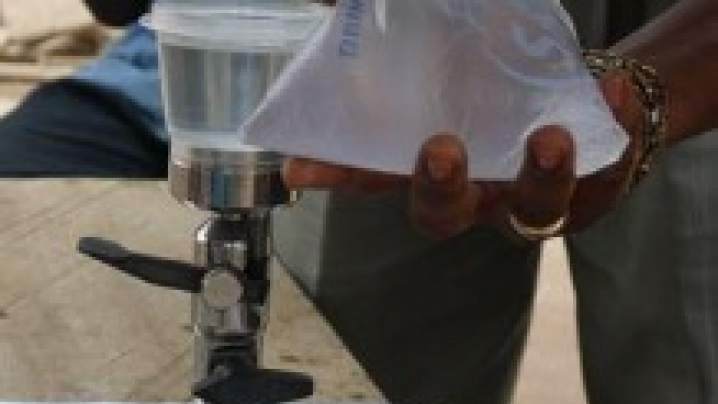
Water quality testing in multi-topic surveys
Since the decision in 2000 to adopt a method based on nationally representative household surveys, the JMP has explored options to report on the quality of drinking water supplies.
The JMP has been collaborating with various large scale household surveys programmes and has developed a standardized module for direct testing of drinking water quality in close collaboration with the Multiple Indicator Cluster Survey (MICS) programme. To date nearly fifty countries have integrated water quality testing in household surveys, a cost-effective way to collect representative data on water quality. Key findings and lessons learned from these experiences are summarized in the JMP thematic report Integrating water quality testing into household surveys. Tools that are part of the MICS support package include the Water Quality Testing Questionnaire and Manual for Water Quality Testing. The module has been adapted for use in the Living Standards Measurement Study (LSMS) as well as the Demographic and Health Surveys (DHS) and a number of nationally-led surveys.
In a research article published in the journal Environmental Health Perspectives “Monitoring Drinking Water Quality in Nationally Representative Household Surveys in Low- and Middle-Income Countries: Cross-Sectional Analysis of 27 Multiple Indicator Cluster Surveys 2014–2020” members of the JMP and MICS team summarize the results from water quality testing to date and examined risk factors for E. coli contamination across the most recent national MICS survey in 27 countries. The study documents widespread E. coli contamination and inequalities between and within countries and finds that water quality is often the limiting factor for safely managed services. Risk factors for E. coli contamination at the point of use included low community sanitation coverage (<75% improved sanitation in the household survey cluster), rural residence and livestock ownership. The evidence generated in these surveys highlights the urgent need for better risk management to reduce widespread exposure to fecal contamination through drinking water services.
The following surveys have been completed:
- Afghanistan ALCS 2016 (pilot in 10 provinces)
- Algeria MICS 2019
- Azerbaijan MICS 2023
- Bangladesh
- Belize MICS 2024
- Benin MICS 2021
- Central African Republic MICS 2018-19
- Chad MICS 2019
- Congo MICS 2014-15
- Côte d'Ivoire
- Democratic Republic of the Congo MICS 2018
- Democratic People's Republic of Korea MICS 2017
- Dominican Republic MICS 2019
- Ecuador ENEMDU 2016
- Eswatini MICS 2021-22
- Ethiopia
- ESS 2016
- DHS 2023
- Federated States of Micronesia MICS 2025
- Fiji MICS 2021 preliminary results and survey findings report
- Gambia MICS 2018
- Georgia MICS 2018
- Ghana
- Guinea-Bissau MICS 2019
- Guyana MICS 2019-20
- Honduras MICS 2019
- Iraq MICS 2018
- Kiribati MICS 2018
- Lao People's Democratic Republic
- Lebanon
- National Water Quality Survey 2016
- MICS 2023
- Lesotho MICS 2018
- Madagascar
- MICS 2018
- MICS 2024
- Malawi
- MICS 2019-20
- MICS 2024
- Mongolia
- Mozambique DHS 2022-23
- Nauru MICS 2023
- Nepal
- Nicaragua MICS 2023
- Nigeria
- Pakistan
- Balochistan MICS 2019-20
- Gilgit MICS 2024
- Khyber Pakhtunkhwa MICS 2019
- Punjab MICS 2017-18
- Sindh MICS 2014
- Sindh MICS 2018-19
- Paraguay MICS 2016
- Samoa DHS-MICS 2019-20
- Sao Tome and Principe MICS 2019
- Sierra Leone MICS 2017
- State of Palestine MICS 2019-20
- Suriname MICS 2018
- Tanzania NPS 2021
- Togo MICS 2017
- Tonga MICS 2019
- Trinidad & Tobago MICS 2022
- Tunisia
- Turks & Caicos MICS 2019-20
- Tuvalu MICS 2019-20
- Vanuatu MICS 2023
- Viet Nam SDGCW 2020-21 snapshot and survey findings report
- Zimbabwe
- MICS 2019 snapshot and survey findings report
JMP Task Force on Water Quality Monitoring
How can the safety of drinking water be monitored globally? What definitions would be meaningful and assist decision-makers in the process of improving the drinking water situation in the world? What research and development efforts are needed to come up with a rapid, reliable and cost-effective way of measuring water quality indicators locally and reporting on them at the global level? To address these questions, the JMP commissioned a Task Force on Water Quality Monitoring which met in 2010 and 2013.
Rapid Assessments of Drinking Water Quality
Between 2002 and 2008 the rapid assessment of drinking water quality (RADWQ) project was implemented in a number of pilot countries where the quality of drinking water from improved sources was evaluated. The RADWQ studies provided important evidence for informing the future SDG targets and indicators.
RADWQ pilot country reports:
Aside from the cost associated with dedicated teams to conduct the survey, one of the key challenges with that RADWQ approach was that in many countries there is no complete sampling frame for water supplies, making it challenging to draw a robust representative sample. In June 2012, the JMP convened an expert meeting to review sampling issues and review the RADWQ Method Handbook.